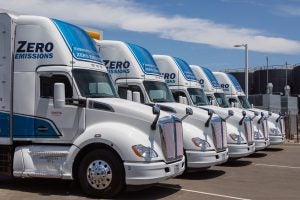The Electric Truck Market Is Ready. Colorado Should Seize The Momentum
 Medium- and heavy-duty trucks only make up 10% of the vehicles on American roads and highways, but they produce a disproportionate amount of climate and local air pollution per mile. That’s why states, cities and counties across the country have been working for years to clean up these critical pieces of our economy.
Medium- and heavy-duty trucks only make up 10% of the vehicles on American roads and highways, but they produce a disproportionate amount of climate and local air pollution per mile. That’s why states, cities and counties across the country have been working for years to clean up these critical pieces of our economy.
Colorado has two urgent opportunities — alongside complementary measures that explicitly prioritize frontline communities — to seize this momentum and produce cleaner air and reduced climate emissions faster.
Building on clean truck momentum
We’ve seen incredible industry progress in the last few years. In North America, more than 165 zero-emission shuttle buses, cargo vans, school buses, tractor-trailers trucks and other models are anticipated this year. There is at least one zero- emission model available across all bus types and class 2b-8 trucks. Based on manufacturer announcements, there will be multiple companies selling zero-emission models in virtually all medium- and heavy-duty market segments by 2025, including 58 percent of the major OEMs. Range, efficiency and costs are all improving, and that trend is expected to continue.
The electric truck market is ready. Colorado should seize the momentum. Share on XColorado is now considering two policies that will spur this transition locally. The first is the Heavy-Duty Omnibus rule, which strengthens nitrogen oxides (NOx) and particulate matter (PM) limits for new medium- and heavy-duty vehicles. Both of these contribute to less pollution and cleaner air.
The second is the Advanced Clean Trucks Rule, which sets modest sales requirements for zero-emission truck manufacturers and then increases them gradually through 2035, on the sound assumptions that technology will continue to improve, making zero-emission vehicles more viable across a range of vehicle types, while upfront and total cost of ownership figures become ever more favorable.
Both are important for Colorado, and the targets set in each are reasonable and achievable.
Cleaner air standards are entirely feasible
The Heavy-Duty Omnibus Rule would reduce NOx emissions from new fossil-fueled trucks and buses by 90% starting in model-year 2027. Nearly a decade of rigorous research and testing by the Southwest Research Institute has demonstrated the 2027 requirements can be met with plenty of margin for a variety of real-world truck routes.
And according to the Manufacturers of Emission Controls Association , its members are developing numerous engines and aftertreatment technologies “to simultaneously meet future NOx and GHG emission standards.”
As innovation continues to drive new and better solutions, fleets will have more and more options to prepare for 2027 and beyond. One project even deployed a Class 8 Peterbilt tractor in Walmart’s fleet capable of meeting the 2027 NOx emission limit while improving fuel economy by 10 percent and using a technology that is expected to cost less than current engines.
The bottom line is simple: the market is ready to achieve the targets in the low-NOx rule.
Advanced Clean Trucks Rule sales targets are flexible and realistic
The Advanced Clean Trucks rule would set sales targets for zero-emission trucks and buses: 15%-20% percent of sales through 2027, depending on class, then increasing steadily after 2027. Based on the number of available models today and manufacturers’ clear intention to bolster the number of available models in coming years, the initial targets are fully realistic.
Moreover, the ACT and Heavy-Duty Omnibus rules each include a credit trading system through which companies who may need additional flexibility can buy credits from companies that are equipped to comply more quickly. The ACT also allows zero-emission credit trading within a company between most truck classes, allowing manufacturers to shift credits from truck segments ripe for electrification to those that are less suitable.
All in all, the ACT would accommodate fluctuations in year-to-year vehicle sales driven by unforeseen macroeconomic events by basing manufacturers’ annual electric vehicle sales requirements on sales from that year. This way, sales peaks or troughs would have an immediate impact on a manufacturer’s target.
Moreover, because it focuses on zero-emission vehicles, whereas the federal proposal does not specify a technology, the ACT can maximize reductions in the state in parallel with the federal proposals.
Fleets and manufacturers are not alone
Federal and state governments are investing billions of dollars to help offset the upfront cost of electric vehicles and infrastructure. At the federal level, both the Infrastructure Investment and Jobs Act and the Inflation Reduction Act contain over $80 billion to spur the decarbonization of this sector.
Colorado already has several programs in place designed to facilitate the transition to zero-emission vehicles, including the Clean Transit Enterprise, Clean Fleet Enterprise, Xcel’s Energy’s Transportation Electrification Plans, the Community Access Enterprise and Innovative Motor Vehicle and Truck Credits.
These state programs will be critically important complements to federal programs. Collectively, this suite of federal and state incentives will help ensure that emission standards like the Advanced Clean Trucks rule are successfully implemented.
The clean truck future is upon us. The models are ready, the market is ready and Coloradoans are more than ready to tackle climate change and improve their air. Colorado should adopt the Heavy-Duty Omnibus Bill’s Low NOx Rule and the Advanced Clean Trucks Rule now and accelerate this critical transformation.
This article is part of a series examining the myriad benefits and feasibility of Colorado adopting the Advanced Clean Trucks and Heavy-Duty Omnibus rules in 2023.
The rest of the series is available at the following links:
Facts about Advanced Clean Trucks in Colorado
Let’s ACT for Clean Trucks and Clean Air
Colorado Must Adopt Clean Truck Rules to Tackle Climate Pollution
The three biggest reasons we need cleaner trucks in Colorado










